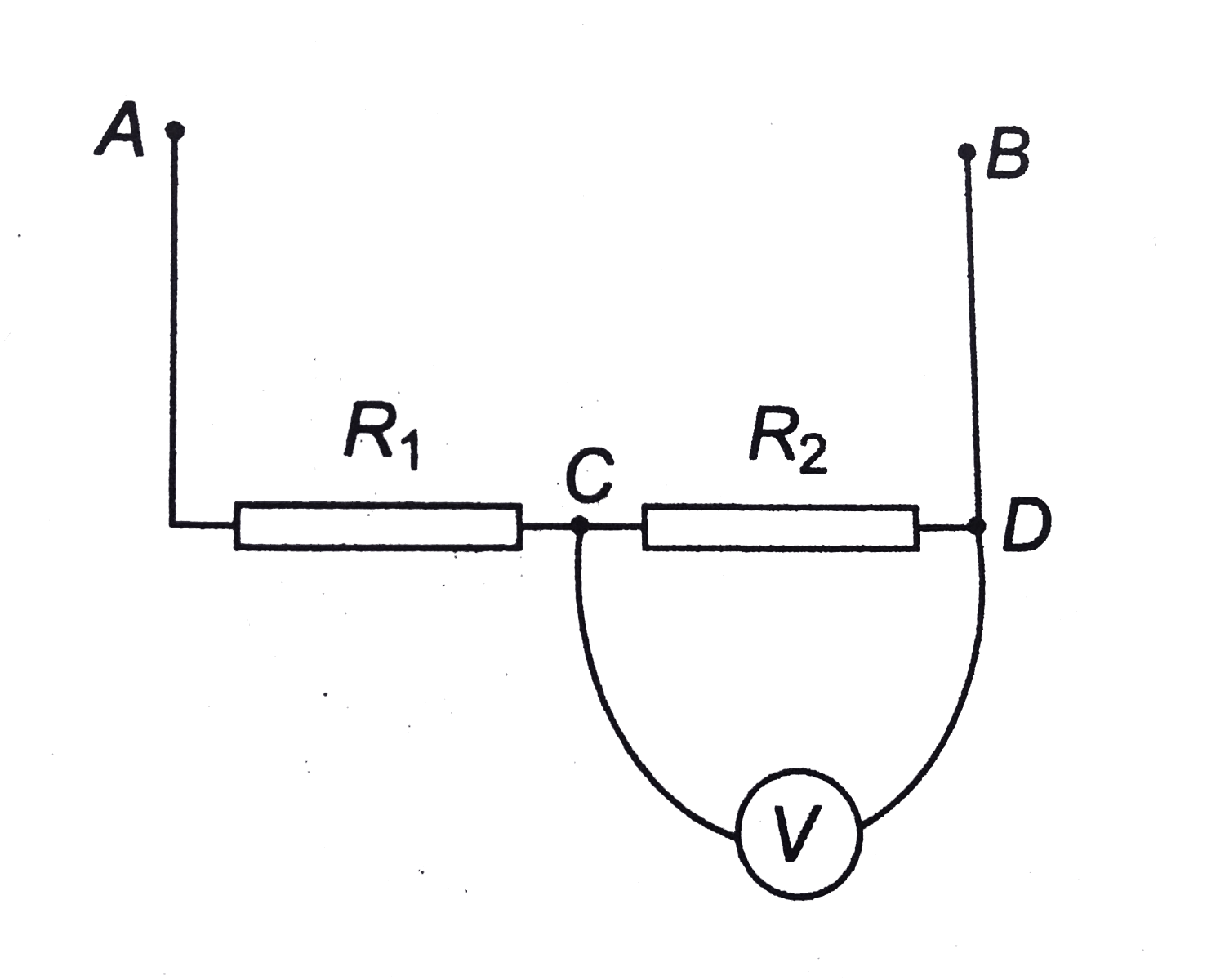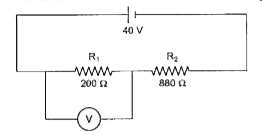(i) In fig. 6.7, find the potential difference berween the points A and B.
(ii) Now we wish to measure this potential difference by using a voltemter of resistance 2kΩ. Find the reading of the voltumeter and percentage error.
(ii) Solve part (ii) if the voltumter were of resistance 20kΩ. What conculsion do you draw from the results you get in the above parts?

As both the resistances are same, 40V will be divided equally among both the resistances. Hence, the potential difference across A and B is 20V.
(ii) Equivalent resistance of 200Ω and 2kΩ is
R1=200×200200+200=200011Ω

Reading of voltmeter = potential difference across AB
=V1=2000/(11×40)2000/(11+200)=19.05V
Percentage error =20−19.0520×100=4.75%
(iii) In this case
R1200×20,000200+20,000=20,000101Ω
Reading of voltmeter
= potential difference across AB
=V2=20,000/(101×40)20,000/(101+200)=19.90V
Percentage error =20−19.920×100=0.5%
In case (iii), percentage error is less than that in case (ii). It means the more the resistance of the voltmeter, the more accurate the reading.
Topper's Solved these Questions
- ELECTRICAL MEASURING INSTRUMENTSBOOK - CENGAGE PHYSICS ENGLISHCHAPTER - ELECTRICAL MEASURING INSTRUMENTSEXERCISE - Solved Examples
4 Videos
- ELECTRICAL MEASURING INSTRUMENTSBOOK - CENGAGE PHYSICS ENGLISHCHAPTER - ELECTRICAL MEASURING INSTRUMENTSEXERCISE - Exercise 6.1
15 Videos
- ELECTRIC POTENTIALBOOK - CENGAGE PHYSICS ENGLISHCHAPTER - ELECTRIC POTENTIALEXERCISE - DPP 3.5
15 Videos
- ELECTROMAGNETIC INDUCTIONBOOK - CENGAGE PHYSICS ENGLISHCHAPTER - ELECTROMAGNETIC INDUCTIONEXERCISE - compression type
7 Videos
Similar Questions
Resistance R1and R2, each 60Ω, are connected in series. The Potential difference between points A and B is 120V. Find the reading of voltmeter connected resistance r=120Ω

View SolutionAs shown in figure a variable rheostat of 2kΩ is used to control the potential difference across 500 ohm load. (i) If the resistance AB is 500Ω, what is the potential difference across the load ? (ii) If the load is removed, what should be the resistance at BC to get 40 volt btween B and C ?

View Solution(a) A voltmeter with resistance Rv is connected across the terminals of a battery of emf E and internal resistance r. Find the potential difference measured by the voltmeter.
(b) IfE=7.50V and r=0.45Ω, find the minimum value of the voltmeter resistance Rv so that the voltmeter reading is within 1.0% of the emf of the battery. (c) Explain why your answer in part (b) represents a minimum value.
View SolutionA standard cell of emf e0=1.11 V is balanced against 72 cm length of a pootentiometer. The same potentiometer is used to measure the potential difference across the stndard resistance R=120Ω. When the ammeter shows a current of 7.8 mA, a balanced lengh of 60 xm is obtained on the potentiometer.

(i) Determine the current following through the resistor.
(ii) Estimate the error in measurement of the ammeter.
View SolutionFigure below shows two resistors R1andR2 connected to a battery having an emf of 40 V and negligible internal resistance. A voltmeter having a resistance of 300 Ω is used to measure potential difference across R1 Find the reading of the voltmeter.

View SolutionYou are given two resistors X and Y whose resistances are to be determined using an ammeter of resistance 0.5Ω and a voltmeter of reistance 20kΩ. It is known that x is in the range of a few ohms. While Y is in the range of several thousand ohms. In each case, while of the following two connections (Fig. 6.35) would you choose for resistance measurement? Justify your answer quantiatively. [Hint : For each connection, determine the error in resistnce measurement. The connection that corresponds to a smaller error (for a given range of resistance) is to be perferred.]

View SolutionThe circuit in Fig. shows two cells connected in opposition to each other. Cell E1 is of emf 6V and internal resistance 2Ω, the cell E2 is of emf 4V sand internal resistance 8ω. Find the potential difference between the points A and B.

View SolutionA voltmeter coil has resistance 50.0(Ω)and a resistor of 1.15k(Ω)is connected in series.It can read potential differences upto 12 volts.If this same coil is used to construct an ammeter which can measure currents up to 2.0A ,What should be the resistance of the shunt used ?
View SolutionA battery of emf 1.4V and internal resistance 2Ω is connected to a resistor of 100ω resistance through an ammeter. This resistance of the ammeter is 4/3Ω. A voltmeter has also been connected to find the potential difference across the resistor.
a. Draw the circuit diagram.
b. The ammeter reads 0.02A. What is the resistance of the voltmeter?
c. The voltmeter reads 1.1V. What is the error in the reading?
View SolutionIn the circuit shown the resistance R is kept in a chamber whose temperature. is 20∘C which remains constant. The initial temperature and resistance of R is 50∘C and 15Ωrespectively. The rate of change of resistance R with temperature is 12Ω/∘C and the rate of decrease of temperature of R is In(3/100) times the temperature difference from the surrounding (Assume the resistance R loses heat only in accordance with Newton's law of cooling) If K is closed at t = 0, then find the
(a) value of. R for which power dissipation in it is maximum.
(b) temperature of R when power dissipation is maximum
(c) time after which the power dissipation will be maximum

View Solution
